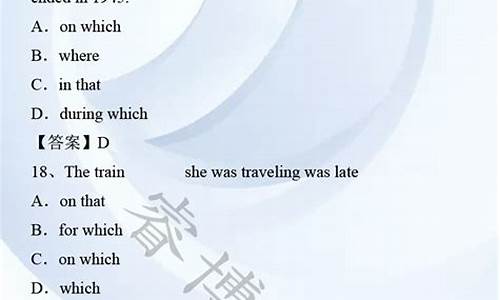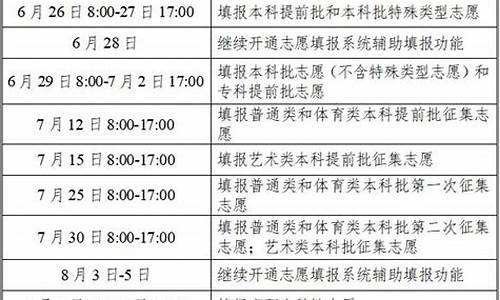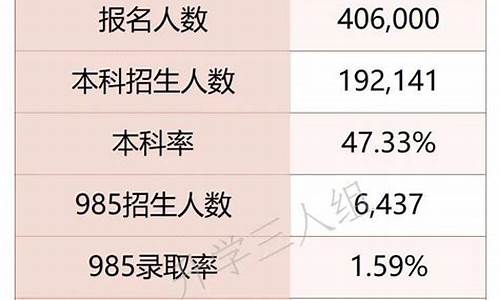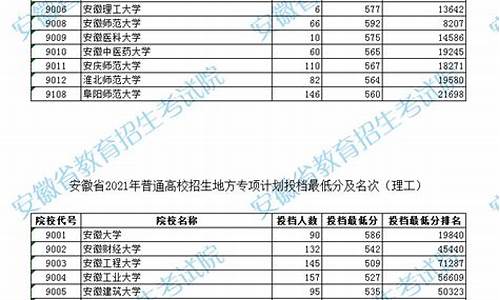您现在的位置是: 首页 > 教育政策 教育政策
2020年高考英语定语从句考点集锦_2013高考定语从句
tamoadmin 2024-05-18 人已围观
简介1.高考英语定语从句怎么学?一:定语从句 定语从句(Attributive Clauses)在句中做定语,修饰一个名词或代词,被修饰的名词,词组或代词即先行词。定语从句通常出现在先行词之后,由关系词(关系代词或关系副词)引出。 关系代词有:who, whom, whose, that, which等。 关系副词有:when, where, why等。 18.1 关系代词引导的定语从句 关系
1.高考英语定语从句怎么学?

一:
定语从句
定语从句(Attributive Clauses)在句中做定语,修饰一个名词或代词,被修饰的名词,词组或代词即先行词。定语从句通常出现在先行词之后,由关系词(关系代词或关系副词)引出。
关系代词有:who, whom, whose, that, which等。
关系副词有:when, where, why等。 18.1 关系代词引导的定语从句
关系代词所代替的先行词是人或物的名词或代词,并在句中充当主语、宾语、定语等成分。关系代词在定语从句中作主语时,从句谓语动词的人称和数要和先行词保持一致。
1)who, whom, that
这些词代替的先行词是人的名词或代词,在从句中所起作用如下:
Is he the man who/that wants to see you?
他就是你想见的人吗?(who/that在从句中作主语)
He is the man whom/ that I saw yesterday.
他就是我昨天见的那个人。(whom/that在从句中作宾语)
2) Whose 用来指人或物,(只用作定语, 若指物,它还可以同of which互换), 例如:
They rushed over to help the man whose car had broken down. 那人车坏了,大家都跑过去帮忙。
Please pass me the book whose (of which) cover is green. 请递给我那本绿皮的书。
3)which, that
它们所代替的先行词是事物的名词或代词,在从句中可作主语、宾语等,例如:
A prosperity which / that had never been seen before appears in the countryside. 农村出现了前所未有的繁荣。(which / that在句中作宾语)
The package (which / that) you are carrying is about to come unwrapped. 你拿的包快散了。(which / that在句中作宾语 18.2 关系副词引导的定语从句
关系副词可代替的先行词是时间、地点或理由的名词,在从句中作状语。
1)when, where, why
关系副词when, where, why的含义相当于"介词+ which"结构,因此常常和"介词+ which"结构交替使用,例如:
There are occasions when (on which) one must yield. 任何人都有不得不屈服的时候。
Beijing is the place where (in which) I was born. 北京是我的出生地。
Is this the reason why (for which) he refused our offer? 这就是他拒绝我们帮助他的理由吗?
2)that代替关系副词
that可以用于表示时间、地点、方式、理由的名词后取代when, where, why和"介词+ which"引导的定语从句,在口语中that常被省略,例如:
His father died the year (that / when / in which) he was born. 他父亲在他出生那年逝世了。
He is unlikely to find the place (that / where / in which) he lived forty years ago. 他不大可能找到他四十年前居住过的地方。
二:宾语从句
宾语从句的连接词
1.连词that,只起连接作用,在从句中不作句子成分,也无词汇意义,在口语中常被省略。
eg. He knew (that) he should work hard.
2.连词if 、whether,它们起连接作用,在从句中不作句子成分,作“是否”解,在口语中多用if。
eg. Tom don't know if/whether his grandpa liked the present.
He asked me whether or not I was coming.
一般情况下,if 和whether可以互换,但以下3种情况只能用whether:
①在不定式前:Whether to go there or not hasn't been decided.
②在介词前:It depends on(依靠) whether it is going to rain.
③与or not连用:They are talking about whether to go there or not.
3.连接代词who, whom, whose, what, which,连接副词when, where, why, how, 它们起连接作用,作句子成分,各有自己的意义。
eg. The teacher asked the new students which class he was in.
I wonder where he got so much money.
注意
1.由连接代、副词引导的宾语从句可以和“疑问词+不定式”结构转化。
eg. I don't know how I should do with the presents. ==> I don't know how to do with the presents.
2.要注意区分判断由if、when引导的从句类型.
二、宾语从句的语序
宾语从句的语序是陈述语序,即“连接词+主语+谓语+其它成分”。特别强调:它的主语和谓语的语序是陈述语序,而不是疑问句的倒装结构。
Can you tell me who(m) do we have to see?(╳)
Can you tell me who(m) we have to see?( √)
The teacher asked the students what they were doing.(思考: what在从句中的成分)
陈述句变为宾语从句时,要注意人称和时态的变化,语序不变。 eg. She said, “I will leave a message on the desk.” → She said she would leave a message on the desk.
一般疑问句和特殊疑问句变为宾语从句时,也要注意人称和时态的变化,后面接陈述语序。Eg. “Where are the tickets?” I asked him. → I asked him where the tickets are.
三、宾语从句的时态呼应
宾语从句中谓语动词的时态,常常受到主句谓语时态的制约,此为时态呼应。如果主句谓语是一般现在时或将来时,从句谓语的时态不受限制;如果主句谓语的时态是一般过去时,从句一般要随着改为相应的过去时态(一般过去时、过去进行时、过去将来时、过去完成时)。
eg. I thought (that) you are free today. (╳)
I thought (that) you would be free today. ( √)
注意当宾语从句叙述的是客观真理时,不管主句谓语的时态如何,从句都用一般现在时。
eg. The teacher told us (that) the earth moves around the sun.
四.其他需要说明的问题
1.标点由主句决定,如主句是陈述句、祈使句,则用句号;是疑问句则用问号。
eg. I heard she had been to the Great Wall. Can you tell me which bus I should take?
2.要注意个别句子中主从句人称的一致。
▲五.宾语从句和状语从句的区分
eg. 1) I will go out tomorrow if it is fine.
2) I don't know if the train has arrived.
句1)中if引导的是状语从句。这个从句表示“条件”,修饰主句。整个句子的意思是如果明天天气好,我就出去。句2)中if引导的是宾语从句,充当谓语动词don't know的宾语。整个句子的意思是我不知道火车是否到达。
判断方法:
1.可以从整个句式看。状语从句一般可以放在主句的前面或后面(个别除外),宾语从句只能放在主句谓语动词之后。
2.从引导词看。if充当宾语从句的连接词时,相当于whether, 词义为“是否”,充当状语从句的连接词时,词义为“如果”。when充当宾语从句的连接词时,意为“什么时候”,充当状语从句的连接词时,意为“当……的时候”。
3.从时态看。if和when作连接词时,引导宾语从句要注意:从句的谓语动词的时态应根据主句的时态作相应的变化。if和when充当从属连词时,引导条件和时间状语从句,若主句的谓语动词用一般将来时,则从句的时态应用一般现在时表示将来。
三:
同位语从句
在复合句中充当同位语的名词性从句称为同位语从句。同位语从句是名词性从句(主语从句、表语从句、宾语从句、同位语从句)中的主要从句之一,也是中学英语学习中的重点语法知识点之一。在使用同位语从句时,应注意以下五个方面:
一、同位语从句在句中的位置
1.一般情况下同位语从句跟在某些名词(如news,idea,fact,promise,hope,message等)的后面,用以说明该名词所表达的具体内容。
例如:
The news that our women volleyball team had won the championship encouraged us all greatly.我们女排赢得冠军的消息大大地鼓舞了我们所有人。
I've come from Mr Wang with a message that he won't be able to see you this afternoon.我从王先生那边得知一个消息,他说他今天下午不能来看你了。
2.有时同位语从句可以不紧跟在它所说明的名词后,而被别的词语隔开,在语法上叫做分隔式同位语从句。
例如:
The thought came to her that maybe she had left the door open when she left home.她突然想起可能在她离开家时没把门关上。
The story goes that he failed in the College Entrance Examinations again.据说他高考(高考新闻,高考说吧)又落榜了。
二、同位语从句前名词的数
同位语从句前的名词通常用单数形式,并且往往带有限定词(word除外)加以修饰。例如:
Where did you get the idea that I could not come?你在哪儿听说我不能来?
Give me your promise that you will come to our party this evening.答应我,你今天晚上要来参加我们的晚会。
Word came that China launched its first manned spaceship on Oct 15,2003.消息传来,中国于2003年10月15日首次成功发射了载人飞船。
三、同位语从句连接词的选用
在英语中,引导同位语从句的词通常有连词(that,who,whether),连接副词(how,when,where)等。例如:
They were all very much worried over the fact that you were sick.对你生病这件事,他们都很焦虑。
The question who should do the work requires consideration.谁该做这项工作,这个问题需要考虑。
We haven't yet settled the question where we are going to spend our summer vacation.我们还没有决定到什么地方去度暑假。
注:在名词doubt“怀疑”后的同位语从句用whether连接;在no doubt“不怀疑”之后的同位语从句用that连接。例如:
We have some doubt whether they can complete the task on time.我们怀疑他们是否能准时完成任务。
There is no doubt that Zhang Wei will keep his promise.我们相信张卫会守信的。
同位语从句:that
有些名词的后面可以接that引导的同位语从句:
We came to the decision that we must act at once.我们做出决定:我们必须立即行动。
He made a proposal that the meeting be postpone.他提议会议延期。
There was little hope that he would survive.他幸存的希望很小。
以下名词常用于以上句型:
advice,announcement,argument,belief,claim,conclusion,decision,evidence,explanation,fact,feeling,hope,idea,impression,information,knowledge,message,news,opinion,order,probability,promise,proposal,remark,reply,report,saying,statement,suggestion,thought,treat,warning,wish,word
同位语从句:whether
whether可以引导同位语从句,而定语从句不能用whether作为引导词。
He hasn't made the decision whether he will go there.他还没有做出决定是否去那里。
I have small doubt whether he is suitable for the job.他是否适合这件工作我有点怀疑。
同位语从句:what
what可以引导同位语从句,而定语从句不能用what作为引导词
I have no idea what he is doing now.我不知道他现在在干什么。
同位语从句:how
how可以引导同位语从句,而定语从句不能用how作为引导词
It's a question how he did it.那是一个他如何做了此事的问题。
同位语从句:who等
who,whom,which,when,where,why用来引导同位语从句
The question who should do the work requires consideration.谁该干这项工作,这个问题需要考虑。
She raised the question where we could get the fund.她提出这个问题:我们到哪儿去搞这笔资金。
四、同位语从句的语气
在suggestion,advice,request,order等意为“建议;命令;要求”的名词后,同位语从句中的谓语动词通常用“should +动词原形”的虚拟语气结构,句中的should可以省略。例如:
Our teacher gave us some advice how we(should)use the computer.老师给我们提出了一些如何使用电脑的建议。
The suggestion came from the chairman that the new rule(should)be adopted.采纳新规则的建议是主席提出来的。
The government gave the order that all these houses(should)be pulled down in three weeks.政府下令三个星期内所有这些房子都要拆掉。
五、同位语从句与定语从句的用法区别
区别(1)
同位语从句和先行词是同等的关系;而定语从句是用来修饰先行词,是从属的关系。
区别(2)
that在同位语从句中没有词义,不充当句子成分;而在定语从句中充当主语、宾语等句子成分。
区别(3)
whether,what,how可以用来引导同位语从句;而它们不能用来引导定语从句。
区别(4)
1.从词义角度看问题
who,whom,which,when,where,why用来引导同位语从句是保持原来疑问词的含义;它们用来引导定语从句时,不具有疑问词的含义。
2.从搭配角度看问题
who,whom,which,when,where,why用来引导定语从句时对应性很强,如:
先行词是“人”,引导词用“who”等,而它们引导同位语从句是先行词通常是“question,idea,doubt等”。
六、典型例题
例1:I have no idea when he will be back.
析:he will be back意义不完整,应加“什么时候”的含义才能表达idea的全部内容,因此应用when引导同位语从句。
例2:I have no impression how he went home,perhaps by bike.
析:he went home意义不完整,应加“如何”的含义才能表达impression的全部内容,因此应用how引导同位语从句。
例3:Information has been put forward ____ more middle school graduates will be admitted into universities.(NMET2001上海)
A.while B.that C.when D.as
析:答案为B.more middle school graduates will be admitted into universities是Information的内容,且Information不在从句中作成分,所以该句为同位语从句。应将该句区别于:
It is said that more middle school graduates will be admitted into universities,this is the information ____ has been put forward.
A.what B.that C.when D.as
析:答案为B.that has been put forward为information的修饰性定语,且information在从句中作主语,所以该句为定语从句。
例4:She heard a terrible noise,____ brought her heart into her mouth.(MET91)
A.it B.which C.this D.that
析:答案为B.分析语境含义、句子结构和句子成分可知,该句为非限制性定语从句,先行词为a terrible noise,且它在从句中作主语。应将该句区别于:
I can’t stand the terrible noise ____ she is crying loudly.
A.it B.which C.this D.that
析:答案为D.she is crying loudly是the terrible noise的内容,且the terrible noise不在从句中作成分,所以该句为同位语从句。
高考英语定语从句怎么学?
定语从句
1.由一个句子作定语,修饰句中一个名词或代词,有时也可以修饰整个句子或句中的部分内容,这样的从句就是定语从句,被其修饰的名词或代词叫先行词。
2.关系词分为两大类,即关系代词和关系副词,其作用一是引出一个定语从句,二是代替其所修饰的`先行词,三是在句中充当某个句子成分。
关系词的分类和基本用法
表一
分类指代引导词
关系代词人who, whom, that, as
事物which, that, as
人或物(表所属关系)Whose
关系副词地点Where
时间When
原因Why
表二
关系代词指代例句解释
who人The man who helped you is Mr White.在定从中作主语
whomThat is the person(whom/who/that) you want to see.在定从中作宾语,可省略
whoseHe is the father whose son studies very well in our class.在定从中作定语
thatIm not the fool that you thought me to be.在定从中作表语
asHe is such a lazy man as nobody wants to work with.在定从中作宾语
that事物The only thing that we can do is to give you some advice.在定从中作宾语
whichA dictionary is a useful book which tells us the meaning of words在定从中作主语
whoseHe lives in a room whose window faces south在定从中作定语
asIt is such a big stone as nobody can lift.在定从中作宾语
整句内容As is known to all, he is the best student.在定从中作主语
表三
关系副词指代例句解释
when时间Would you suggest a time when we can have a talk?在定从中作状语
where地点The house where they live is not very large.在定从中作状语
why原因This is the reason why he did not came to the meeting.在定从中作状语
一. 定语从句的概念
在复合句中,修饰某一名词或代词的从句叫定语从句。被修饰的名词或代词叫先行词,引导定语从句的词叫关系词,定语从句一般放在先行词的后面。
二. 引导定语从句的关系词
引导定语从句的关系词有关系代词和关系副词,常见的关系代词包括that, which, who(宾格whom,所有格whose)等,关系副词包括where, when, why等。关系代词和关系副词放在先行词及定语从句之间起连接作用,同时又作定语从句的重要成分。
三. 定语从句的'分类
根据定语从句与先行词的关系,定语从句可分为限制性定语从句及非限制性定语从句。限制性定语从句紧跟先行词,主句与从句不用逗号分开,从句不可省去。非限制性定语从句与主句之间有逗号分开,起补充说明作用,如省去,意思仍完整。
四. 关系代词的用法
1. that 既可以用于指人,也可以用于指物。在从句中作主语、宾语或表语。作主语时不可省略,作宾语可省略。例如:
Mary likes music that is quiet and gentle.
玛丽喜欢轻柔的音乐。(that作主语)
The coat (that) I put on the desk is blue.
我放在桌子上的那件外套是蓝色的。(that作宾语)
2.which用于指物,在句中作主语、宾语或表语。作主语不可省略,作宾语可省略。例如:
The building which stands near the train station is a supermarket.
位于火车站附近的那座大楼是一家超市。(作主语)
The film (which) we saw last night was wonderful.
我们昨天晚上看的那部**很好看。(作宾语)
3.who, whom用于指人,who 用作主语,whom用作宾语。在口语中,有时可用who代替whom。who和whom作宾语时也可省略。例如:
The girl who often helps me with my English is from England.
经常在英语方面帮助我的那个女孩是英国人。(作主语)
Who is the teacher (whom) Li Ming is talking to?
正在与李明谈话的老师是谁?(作宾语)
注意:
(1)当定语从句中含有介词,介词放在句末时,who,whom,that, which可省略,但介词在关系代词前时,只能用?介词+which/whom?结构。例如:
This is the house in which we lived last year.
这是我们去年居住的房子。
Please tell me from whom you borrowed the English novel.请告诉我你从谁那借的这本英文小说。
(2)含有介词的固定动词词组中,介词不可前置,只能放在原来的位置上。例如:
This is the person whom you are looking for.
这就是你要找的那个人。
(3)that 作介词的宾语时,介词不能放它的前面,只能放在从句中动词的后面。例如:
The city that she lives in is very far away.
她居住的城市非常远。
(4)关系词只能用that的情况:
a. 先行词被序数词或形容词最高级所修饰,或本身是序数词、基数词、形容词最高级时,只能用that,而不用which.例如:
He was the first person that passed the exam.
他是第一个通过考试的人。
b. 被修饰的先行词为all, any, much, many, everything, anything, none, the one等不定代词指物时,只能用that,而不用which.例如:
Is there anything that you want to buy in the shop?
你在商店里有什么东西要买吗?
c. 先行词被the only, the very, the same, the last, little, few 等词修饰时,只能用that,而不用which.例如:
This is the same bike that I lost.
这就是我丢的那辆自行车。
d. 先行词里同时含有人或物时,只能用that, 而不用which.例如:
I can remember well the persons and some pictures that I saw in the room.
我能清楚记得我在那个房间所见到的人和一些照片。
e. 以who或which引导的特殊疑问句,为避免重复,只能用that.例如:
Who is the girl that is crying?
正在哭泣的那个女孩是谁?
f. 主句是there be 结构,修饰主语的定语从句用that,而不用which,例如:
There is a book on the desk that belongs to Tom.
桌子上那本书是汤姆的。
(5)关系词只能用which,而不用that 的情况:
a. 先行词为that, those时,用which, 而不用that.例如:
What?s that which is under the desk?
在桌子底下的那些东西是什么?
b. 关系代词前有介词时,which,而不用that.例如:
This is the room in which he lives.
这是他居住的房间。
c. 引导非限制性定语从句,先行词指事物时,用which, 而不用that,例如:
Tom came back, which made us happy.
汤姆回来了,这使我们很高兴。
五. 关系副词的用法
1. when指时间,其先行词表示时间,when在定语从句中作时间状语。例如:
This was the time when he arrived.
这是他到达的时间。
2. where指地点,其先行词表示地点,where在定语从句中作地点状语。例如:
This is place where he works.
这是他工作的地点。
3. why 指原因,其先行词是原因,why在定语从句中做原因状语。例如:
Nobody knows the reason why he is often late for school.
没人知道他为什么上学总迟到。
好啦,关于定语从句,你学会了吗?









